Wilton: Town of Mints, Saints and Carpets
by Moira Allen
 The town of
Wilton lies just ten minutes away from downtown Salisbury (or
half an hour if you happen to hit "rush-hour" traffic).
It's a lovely town that offer several sites worth seeing, and
it's well worth a visit if you'd like to shop or get a bite to
eat in relative peace and quiet. The town of
Wilton lies just ten minutes away from downtown Salisbury (or
half an hour if you happen to hit "rush-hour" traffic).
It's a lovely town that offer several sites worth seeing, and
it's well worth a visit if you'd like to shop or get a bite to
eat in relative peace and quiet.
The town takes its name from the same source as the county of
Wiltshire as a whole: The Wilsaetes tribe, who took their
name from the River Wylye, near which they lived. Wilton is
first mentioned in 802 as Wilsaete, and later as Wiltunscir
(Wilton-shire), but probably existed as a town or village since
at least the middle of the 8th century. By the 9th century, it
had become the royal seat of the kingdom of Wessex, and remained
so until King Alfred moved the royal seat to Winchester. It was
also, on and off, the seat of the bishop of Wiltshire; in 970,
Oswulf, described both as the bishop of Sonning and the bishop of
Wiltshire, was buried at Wilton.
Several factors contributed to Wilton's importance during the
Middle Ages. It was the site of the oldest mint in Wiltshire;
coins were first minted in Wilton during the reign of King Edgar
of Wessex (great-grandson of Alfred the Great), who came to the
throne in 959. The mint remained active until Henry III shut
down all "provincial" mints in 1250, despite a brief
retreat to the safety of Old Sarum when Swein's Danish Vikings
sacked Wilton in 1003. Since a law of Athelstan prohibited the
minting of coins except in a "port" (town), this
indicates that Wilton had a town charter for an early date.
Wilton was also the site an abbey dedicated to St. Mary and St.
Bartholomew. This was originally founded as an Anglo-Saxon
nunnery by Weolkstan, Earl of Ellandum, in 773, and from the
beginning it attracted nuns from noble and even royal families;
it was also the home of Wilton's own saint, Edith, who was the
daughter of King Edgar. Her tomb attracted many visitors and
pilgrims to Wilton, for she had a reputation for healing. In the
13th century the nunnery was replaced by a Benedictine abbey. By
the time it was closed by King Henry VIII in 1539, its income was
the fourth highest in the country. Wilton was also believed to
have possessed no fewer than twelve separate churches at its
heyday.
Finally, Wilton was located at the convergence of several major
roads, including the "Port Herepath" (town highway),
the "Wiltenweye" leading from Hampshire, and the
"Theod Herepath" (people's highway) that lead to the
Avon Valley. Traffic on these roads made Wilton the ideal
location for a market town. Its town charter was confirmed in
1154 by King Henry, and again by King John in 1204. This latter
charter cost the burgesses 100 marks and 700 ells (875 yards) of
linen, suggesting that clothmaking was by this time one of the
town's primary trades.
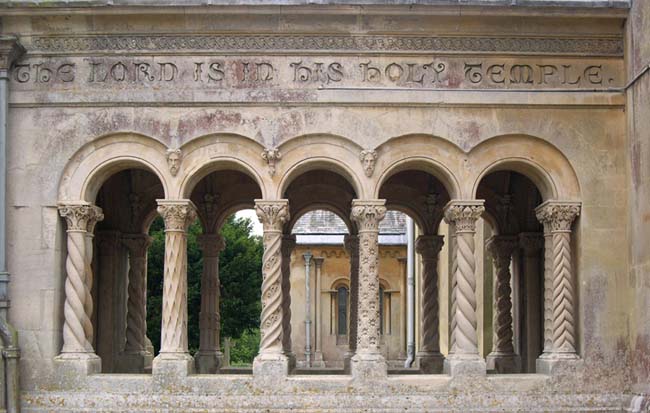
Wilton was also an excellent defensive location, being set upon a
ridge and enclosed by rivers on two sides. Despite this, it was
burned to the ground twice by the Danes. In 871, the Danes
defeated King Alfred's forces at Wilton, leading to a temporary
truce between the Wessex Saxons, who offered to pay a Danegeld to
buy time to regroup. In 1003, the town was burned by the Viking
forces of Swein, who had attacked England in retaliation for King
Ethelred's massacre of Danes residing in England (including
Swein's sister). Ultimately Swein defeated Ethelred and drove
him into exile, becoming the de facto king of England.
The town was put to the torch yet again in 1143 by the forces of
Empress Maud, led by Robert of Gloucester, who surprised King
Stephen's army in the process of attempting to fortify the town
(and more specifically, the abbey). Being built mostly of wood,
the abbey was nearly completely restored, but was soon rebuilt in
stone. Yet another fire destroyed 25 houses, workshops, looms
and outbuildings in the weaving district in1769, but at least
this had nothing to do with invading armies!
The ultimate blow to Wilton's prominence, however, was not due to
marauding Danes, but to the rise of Salisbury in the 13th
century. With its new cathedral, Salisbury became the official
bishop's seat for Wiltshire, and the growing town began to
supplant Wilton's own market. A new bridge over the River Avon
added to Wilton's problems, for it created a bypass that directed
traffic to Salisbury. As towns were repopulated after the Black
Death, residents and tradespeople tended to move to Salisbury,
leaving houses and shops in Wilton to literally stand empty and
decay. Eventually, Wilton's primary economic activity was the
cloth trade, augmented by the wool market that had once belonged
to the abbey, but was granted to the town in 1433. By 1901,
nearly 100,000 sheep were being sold annually in this market.
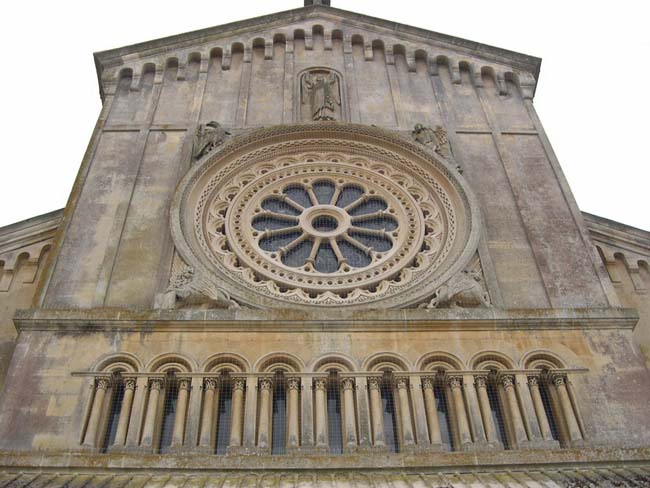
In 1741, the Earl of Pembroke smuggled two French weavers into
England to introduce new carpet-weaving techniques to Wilton.
This resulted in a new rise in prosperity as carpet factories
sprouted up around the town. However, both cloth and carpet
factories suffered another blow in the 19th century when many
proved unable to make the switch from water to steam power. The
main carpet factory in Wilton shut down in 1904, but was reopened
by Lord Pembroke as the Wilton Royal Carpet Factory, which
flourished until being shut down again in 1995 by another
takeover. It again reopened and today produces high-quality
Wilton and Axminster carpets (and if you take the Wilton Carpet
Factory tour, you'll learn how to tell the difference!).
Today, about all that remains of medieval Wilton is the layout of
the streets (and even some of the names have changed). From the
17th century onward, waves of new building and reconstruction
have either obliterated or refaced the town's medieval buildings.
Most of the twelve churches of Wilton had vanished by the 18th
century, and many had been in ruins long before that. In 1738, a
new town hall was built over the old Guildhall, and in 1845,
Wilton's new "Italianate" church replaced its last
medieval parish church (whose ruins can still be seen in the town
centre, as part of a "Garden of Peace" established in
1938).
When Henry VIII dissolved Wilton Abbey in 1539 (or 1536,
depending on which accounts you read), most of the estate was
granted to Sir William Herbert, who became the first Earl of
Pembroke in 1551. He built the first Wilton House on the site of
the abbey, using much of the abbey's stone in the process.
Indeed, many houses in Wilton are believed to include stones from
the old abbey and chapels, including flints gathered by St. Edith
herself.
Today, Wilton offers three major attractions that should not be
missed: Wilton House, the Italianate Church, and the Wilton
Carpet Factory Museum.
The Wilton Italianate Church
Wilton's Church of St. Mary and St. Nicholas, also known as the
Italianate Church, was built between 1841 and 1845 to replace the
original medieval parish church that was falling into decay. The
new church was designed by Thomas Henry Wyatt and David Brandon.
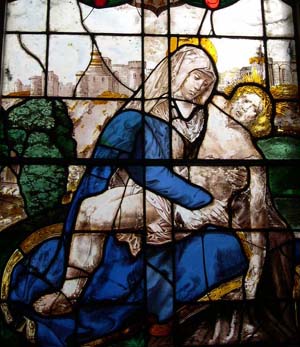 The first thing that will strike the visitor
about this impressive church is that it does not look like one's
typical English parish church. The Byzantine design is inspired
by a Roman basilica, while the mosaics of the nave will put one
in mind of Greek or Russian Orthodox styles. This may not be a
coincidence, as the church was built at the behest of the Dowager
Countess of Pembroke, who was born in Russia. Some believe that
the church's unusual north-south orientation (most English
churches are built upon an east-west axis) was also the wish of
the countess, as this was a custom in Russia. It's likely,
however, that this orientation was chosen so that the church
would directly face the road. The first thing that will strike the visitor
about this impressive church is that it does not look like one's
typical English parish church. The Byzantine design is inspired
by a Roman basilica, while the mosaics of the nave will put one
in mind of Greek or Russian Orthodox styles. This may not be a
coincidence, as the church was built at the behest of the Dowager
Countess of Pembroke, who was born in Russia. Some believe that
the church's unusual north-south orientation (most English
churches are built upon an east-west axis) was also the wish of
the countess, as this was a custom in Russia. It's likely,
however, that this orientation was chosen so that the church
would directly face the road.
Many of the construction materials were imported from Europe,
including black marble columns from the 13th-century Capocci
Shrine from the Santa Maria Maggiore in Rome (which had
subsequently ended up in the garden of Horace Walpole).
Materials from this shrine are also included in the pulpit, which
is particularly striking with its twisted columns and colored
stone panels (known as Cosmato work). The pulpit was created by
Peter Cavalini, who designed the tomb of Edward the Confessor at
Westminster Abbey. The marble columns supporting the arches at
the south end of the side aisles date from 200 BC, and come from
the Temple of Venus at Porto Venere on the Gulf of Spezia. The
lions supporting the front doorposts are carved from stone
brought from the Isle of Man.
The windows include several 12th- and 13th-century panels from
France, as well as painted Flemish or German roundels from the
16th-century. The rose window includes glass from the 16th
century that was originally looted by Napoleon's army. The
church also includes windows brought from the original parish
church, as well as a number of fine contemporary Victorian
windows. A number of memorials and tombs were brought
from the original church, while newer memorials include the
recumbent alabaster figures of Lord Herbert of Lea (d. 1861) and
his mother Catherine, the Countess of Pembroke (d. 1856). The
Dowager Countess left £1,000 in trust for the church, which
was to be invested to maintain the stained glass, mosaics, and
other ornamentation.
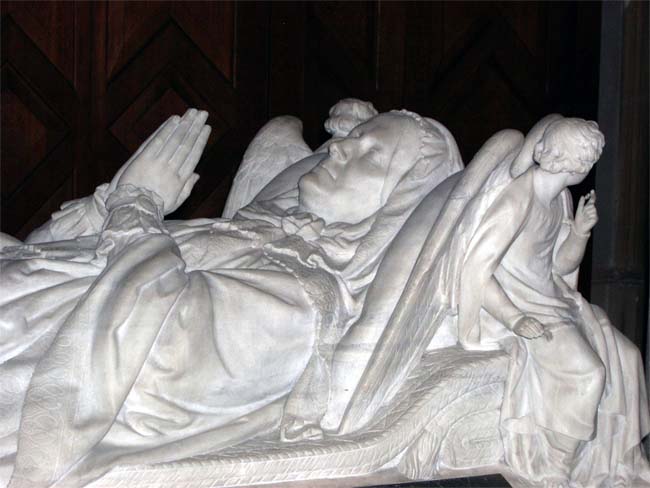
The church stands upon the site of an older St. Nicholas church,
which was already in ruins by the 1400's. Bones disturbed by the
building work are housed in a stone sarcophagus, which stands
against the outer southern wall. Another dramatic feature is the
church's 105-foot campanile, which originally contained six bells
recast from the bells of the original parish church. A new set
of bells was installed in 2000 for the Millenium, and the
originals were sent to Australia.
Wilton House
Wilton House stands on the site of Wilton Abbey, which was
founded as an Anglo-Saxon nunnery in 773 and became a Benedictine
abbey in the 13th century. When it was surrendered in 1536 or
1536 to King Henry VIII, he granted the abbey and lands to Sir
William Herbert, creating the first Earl of Pembroke. Herbert
began building a Tudor manor on the spot in 1543.

Since then, the house has undergone an almost continuous process
of building, expansion, and rebuilding. In 1644, the house was
garrisoned briefly by the Royalists during the Civil War, when
the king sent some of his cannons to the house with a company of
foot soldiers to guard them. The Earl of Pembroke, however,
seems to have come down more on the side of Parliament, as he did
not lose any of his estates during the Interregnum; the house has
remained in the same family since the Earldom was
established.
In 1647, the house was nearly completely destroyed by fire, but
was subsequently rebuilt to a design by Inigo Jones. The 9th
Earl of Pembroke (1733-1750) was known as the "Architect
Earl," and was responsible for landscaping the grounds and
gardens as they are seen today. This included diverting the
River Nadder so that it flowed past the house, to be spanned by a
magnificent Palladian bridge. Across the bridge, below the brow
of the hill, one can see a small classical temple. The 10th Earl,
a cavalry officer, built the Riding School at the northwest
corner of the house, which includes kitchens, a laundry, and
other quarters.
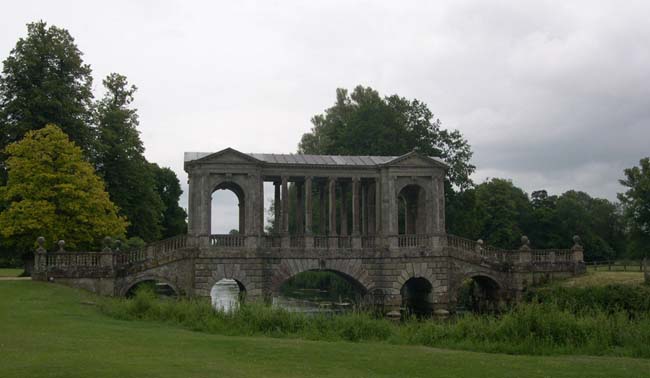
This is where the visitor enters Wilton House today. The main
room of the Riding School is now a miniature museum, filled with
items that have been found in the area or that are associated
with the house. Among these are several highly carved Roman
coffins and other Roman stones. A somewhat more unusual exhibit
is the set of leather horseshoe-covers that were used to shield
the hooves of the draft horses used to mow the extensive lawns
surrounding the house, back when a "riding mower" meant
something very different indeed! You'll then be ushered into a
small room to watch a short and quite entertaining film about the
history of Wilton House, narrated by the ghost of one of the last
abbesses. From there, you proceed through a reconstruction of a
16th-century kitchen (with ghost), forward in time to a Victorian
laundry, and finally into the main house itself.
Wilton House is known for its vast art collection, much of which
was acquired by the 8th Earl. Some rooms are dominated by a few
large paintings; others are lined wall-to-wall and
floor-to-ceiling. Don't miss some of the more interesting pieces
besides the artwork, however, such as a beautiful, multi-colored
glass chandelier, and matching cabinets of inlaid stonework. And
remember that while much of the house is on display, Wilton House
is still the residence of the Earl and Countess of
Pembroke; in fact, during our visit, we glimpsed the countess
taking her dogs for a run by the river.
The gardens are well worth a look, and when you've finished
with the grounds, Wilton House offers a very nice tea-shop where
you can end the afternoon with a cream tea and a choice of cakes
or sandwiches. It was my husband's first introduction to the
cream tea, which he fortunately handled better than my own
"first time," when I assumed that the clotted cream
went into your tea rather than onto the scone.
The Wilton Carpet Factory
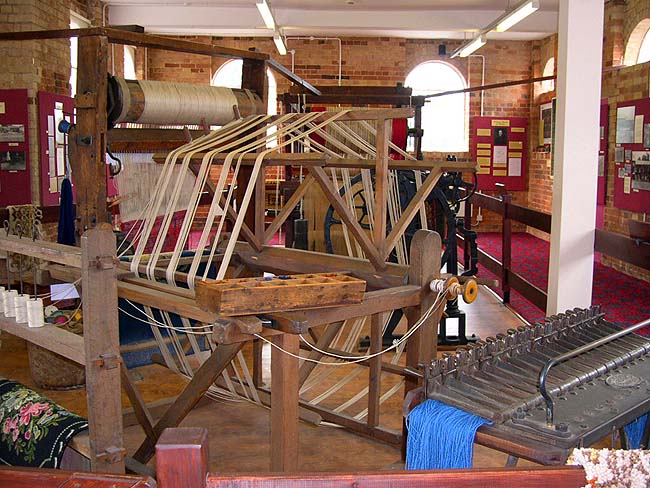
The Wilton Carpet Factory is located the Wilton Shopping Village
just across the road from Wilton House, so it is easy to combine
a visit to both sites at once. A carpet factory might not seem
like the most interesting place to visit (our thought was
"well, we're here..."), but it is more intriguing than
it sounds. A series of wall panels and photos gives the visitor
an overview of the history of carpet-making in the area; then,
you're given a tour of the modern factory and a short lesson on
how Wilton and Axminster carpets are made today. The tour
includes a history of the evolution of many of the machines used
in the process; some of the older ones still use a punched
pattern roll much like a music roll in a player piano. The tour
concludes in a small museum housing a variety of historic looms
and other weaving and carding devices, as well as a small
collection of trade artifacts from the town of Wilton.
From there, you might wish to visit the sandwich shop for a quick
lunch, and do a spot of shopping. The "shopping
village" consists of old factory buildings, many of which
now house factory outlet stores. But beware: if, on your way into
or out of the shopping village, you look remotely as if you might
be carrying food, be prepared to be mobbed by the Wilton Duck
Gang. Many locals obviously come prepared for this, and can be
found buried to the ankles in greedy ducks of just about every
shape, size and color, from itty-bitty ducklings to exceedingly
fat adults. Swans glide a bit more sedately on the River Nadder,
which flows beneath the bridge leading to the carpet factory and
once provided the power for its machines.
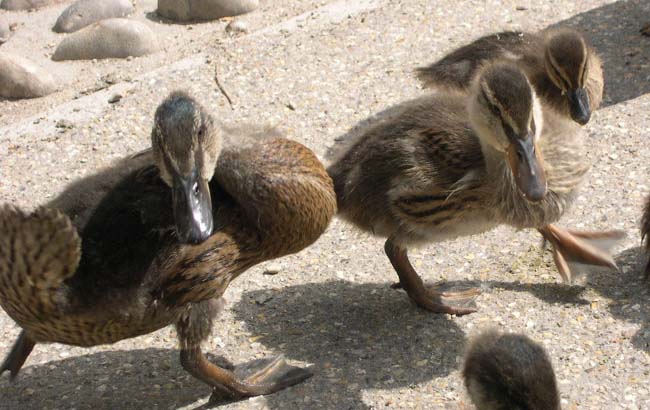
Wilton Italianate Church
Wilton Carpet Factory Museum
Wilton House
The Wilton Duck Gang
Related Articles:
- St. Edith of Wilton, by Moira Allen
- https://www.timetravel-britain.com/articles/history/edith.shtml
- Salisbury: Designed to In-Spire, by Moira Allen
- https://www.timetravel-britain.com/articles/towns/salisbury.shtml
More Information:
We regret that we no longer have the resources to maintain up-to-date links and/or hours and pricing details for the various sites and attractions listed on this website. For more information about the location(s) listed above, please use your favorite search engine or visit Wikipedia.
Moira Allen has been writing and editing professionally for more than 30 years. She is the author of seven books and several hundred articles. She has been a lifelong Anglophile, and recently achieved her dream of living in England, spending nearly a year and a half in the history town of Hastings. Allen also hosts the Victorian history site VictorianVoices.net, a topical archive of thousands of articles from British and American Victorian periodicals. Allen currently resides in Maryland.
Article and photos © 2007 Moira Allen
|
